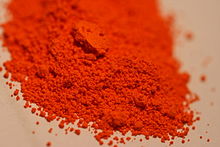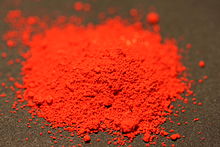| Cadmium orange | |
|---|---|
 Orange cadmium pigment | |
| Hex triplet | #ED872D |
| sRGBB (r, g, b) | (237, 135, 45) |
| HSV (h, s, v) | (28°, 81%, 93%) |
| CIELChuv (L, C, h) | (66, 101, 34°) |
| Source | [1] Charts |
| ISCC–NBS descriptor | Strong orange |
| B: Normalized to [0–255] (byte) | |
| Cadmium red | |
|---|---|
 Red cadmium pigment | |
| Hex triplet | #E30022 |
| sRGBB (r, g, b) | (227, 0, 34) |
| HSV (h, s, v) | (351°, 100%, 89%) |
| CIELChuv (L, C, h) | (48, 155, 11°) |
| Source | ColorHexa |
| ISCC–NBS descriptor | Vivid reddish orange |
| B: Normalized to [0–255] (byte) | |
| Cadmium yellow | |
|---|---|
 Yellow cadmium pigment | |
| Hex triplet | #FFF600 |
| sRGBB (r, g, b) | (255, 246, 0) |
| HSV (h, s, v) | (58°, 100%, 100%) |
| CIELChuv (L, C, h) | (95, 104, 82°) |
| Source | ColorHexa[2] |
| ISCC–NBS descriptor | Vivid greenish yellow |
| B: Normalized to [0–255] (byte) | |
| Cadmium green | |
|---|---|
| Hex triplet | #006B3C |
| sRGBB (r, g, b) | (0, 107, 60) |
| HSV (h, s, v) | (154°, 100%, 42%) |
| CIELChuv (L, C, h) | (39, 44, 142°) |
| Source | ColorHexa |
| ISCC–NBS descriptor | Deep yellowish green |
| B: Normalized to [0–255] (byte) | |
Cadmium pigments are a class of pigments that contain cadmium. Most of the cadmium produced worldwide has been for use in rechargeable nickel–cadmium batteries, which have been replaced by other rechargeable nickel-chemistry cell varieties such as NiMH cells,[3] but about half of the remaining consumption of cadmium, which is approximately 2,000 tonnes (2,200 short tons) annually, is used to produce colored cadmium pigments. The principal pigments are a family of yellow, orange and red cadmium sulfides and sulfoselenides, as well as compounds with other metals.[4]
Cadmium is toxic to humans and other animals in very small amounts, especially when it is inhaled, which often happens when working with powdered pigment or breathing the dust from chalk pastels. As a result, it is not appropriate for children to use any art supplies that contain cadmium pigments. However, because the pigments have some desirable qualities, such as resistance to fading, some adult artists continue to use them.
- ^ "THE MOTHER OF ALL HTML COLOR CHARTS index and reference | Color World | Color, Chart, Color names". tx4.us. Archived from the original on 22 November 2012. Retrieved 11 May 2019.
- ^ "Cadmium yellow / #fff600 hex color". ColorHexa. Retrieved 19 December 2022.
- ^ "MEPs Ban Cadmium from Power Tool Batteries and Mercury from Button Cells". European Parliament. 10 October 2013.
- ^ Müller, Hugo; Müller, Wolfgang; Wehner, Manfred; Liewald, Heike. "Artists' Colors". Ullmann's Encyclopedia of Industrial Chemistry. Weinheim: Wiley-VCH. doi:10.1002/14356007.a03_143.pub2. ISBN 978-3527306732.